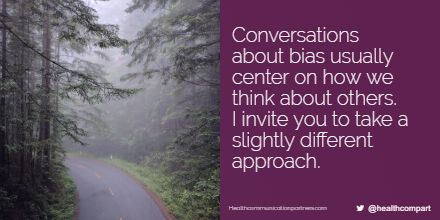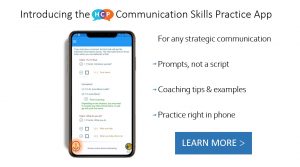 Many of you read this site and tune in to our podcast series because you value reflective practice, thoughtful and intentional use of language, and reducing health disparities.
Many of you read this site and tune in to our podcast series because you value reflective practice, thoughtful and intentional use of language, and reducing health disparities.
You’re aware by now that health disparities are due to many factors that are man-made. And that one of them is implicit or unconscious bias.
You probably already know that everyone has bias, and that the implicit bias scores of providers are similar to those in the general population. This 2015 AJPH study summarizes some different forms that unconscious actions and attitudes can take in the care setting:
“Subtle biases may be expressed in several ways: approaching patients with a dominant and condescending tone that decreases the likelihood that patients will feel heard and valued by their providers, failing to provide interpreters when needed, doing more or less thorough diagnostic work, recommending different treatment options for patients based on assumptions about their treatment adherence capabilities, and granting special privileges, such as allowing some families to visit patients after hours while limiting visitation for other families.”
Conversations about bias usually center on how we think about others. But I’m inviting you to take a slightly different angle.
A different look at difference
I’m particularly interested in the ways language use relates to equity, in and beyond the health sector. There’s a significant body of work on these relationships, and I’m drawing on it to offer some ideas that I hope will be helpful when it comes to thinking and action around bias.
How we think about others has a good deal to do with how we think about ourselves. And that’s where I’m going to park it for a bit.
When we talk or write, we can all tend to think of the sentences we use–the words and phrases we choose–as normal, natural, value-free, or neutral. But it turns out there’s quite a lot going on beneath the surface of our ordinary, everyday language use.
I’ve written before about how linguists demonstrate that our words reflect what we think is normal. Our language reveals our perspective on what Gee calls “being ‘normal,’ ‘acceptable,’ ‘right,’ ‘real,’ ‘the way things are,’ ‘the ways things ought to be,’ ‘possible,’ or ‘what people like us do’.” (p.2)
We get these ideas about what’s normal–and the phrases we use to express them–over time, through the many communities we’re part of. These are reinforced through media we consume, or casual talk at dinner, or our social media activity, for example.
Gee adds that the perspectives we take on normal “all have deep implications for how we believe or wish potential social goods are or ought to be distributed. They have deep implications, as well, for how we act in regard to those beliefs and wishes” (p.2). Almost without noticing it, we speak to what we think ought to be important, what should be done, and our words do this work for us.
Why is this important? Because our normal can be linked to a different kind of bias.
Another kind of bias
A funny thing about our perspectives is that they can become invisible to us. I still struggle to get outside of my own perspective–and my cross-sector work depends on it!
I’m not alone in this. There is an allegory in anthropology and ethnography, that my late professor Brian Street retold several times: the fish would be the last creature to discover water.
It’s doggedly hard to notice our normal. So this allegory is used to caution researchers against what’s called the ethnocentric bias. You could think of it as our tendency to take for granted our own cultural practices. This isn’t so much of a big deal…until we interact with other people and their cultural practices.
That’s when another tendency can kick in, related to the ethnocentric bias: the tendency to describe something different from us as something less than us.
You could liken this to going to a new town, or even a new restaurant: we might judge it according to what it doesn’t have that we’re used to having. We can focus on perceived weaknesses based on what we think is (or should be) normal. Basic. Fundamental. The way it ought to be.
That’s how the ethnocentric bias can get us in trouble when we don’t notice it’s there.
Assumptions and other people
As health professionals, you have the most well-informed perspectives on health of anyone. You worked hard for many years to gain this perspective, and continue to work to deepen and refine it. You don’t expect the rest of us to be experts, or to know what you know.
You do, however, have expectations about what normal people should or ought to know, or do, when it comes to health.
Expert or not, we all have ideas about what counts as normal in health (and in healthcare). We each draw on a range of ways of understanding the body. The same can be said for how we make sense of science, procedures, insurance, nutrition, and more.
These understandings of health are culturally mediated. In other words, our ideas of what health looks like–what’s normal or acceptable when it comes to health–are shaped by our knowledge, our experiences, and how we process this knowledge and experience. All of this happens in and through our communities.
Why am I telling you this? Because, as I said before, the real fun comes when you interact with other people and their potentially different ways of understanding health.
Mind the gap
Remember that ethnocentric bias? Among other things, it can lead us to focus on a person’s perceived weaknesses, based on what we think is or should be normal, basic, or fundamental for people in general. Sometimes without noticing, we measure others up against some standard of ‘normal’ we consciously or unconsciously hold. When they seem too different from what we think of as normal, the difference can be perceived as negative.
For example, I’m not the only one to have pointed out how research in the health literacy field can tend to get stuck on negative depictions of people. You may have noticed that many articles about health literacy focus on how “low” some population’s health literacy is taken to be. That is not to say that the writers hold negative opinions of these populations, but that a deficit perspective has come through in many articles.
When I talk to health care workers, I remind them about the ethnocentric bias, and how easy (and largely unconscious) it can be to think of other people’s ways of doing things as problematic. Especially when it’s not what you think is or should be normal, basic, fundamental, or common sense for people in general. This applies to how patients understand their bodies and act upon health information.
Looking at patients’ knowledge and ideas as a “gap” between you makes the relationship tricky in another way as well. It can suggest that patients make “progress” the closer they move to your idea of what normal people do.
What you can do
To be clear: this isn’t about not having standards. It’s about being intentional and mindful about the standards you do have. This means examining your standards–including your assumptions about what’s normal for people in general–so they are what you want them to be.
I’ll invite you to slow down the speeding train of thought and interrogate some of your assumptions. Reflection plays a crucial role in this process.
Ask yourself:
- What do I tend to take for granted about being healthy?
- What do I consider basic or common sense when it comes to staying healthy?
- What do I consider ‘normal’ displays of intelligence?
- What does an appropriate show of curiosity look like to me? How about concern? Commitment? Affection? Attention?
Get to know your ‘normal.’ Have standards. Look closely at what yours are, and at what it means to hold those standards and not others.
If you get stuck on this, don’t worry; there’s a trick. Listen to yourself when you talk to patients or clients. Even for just one day.
Image by Gerd Altmann

